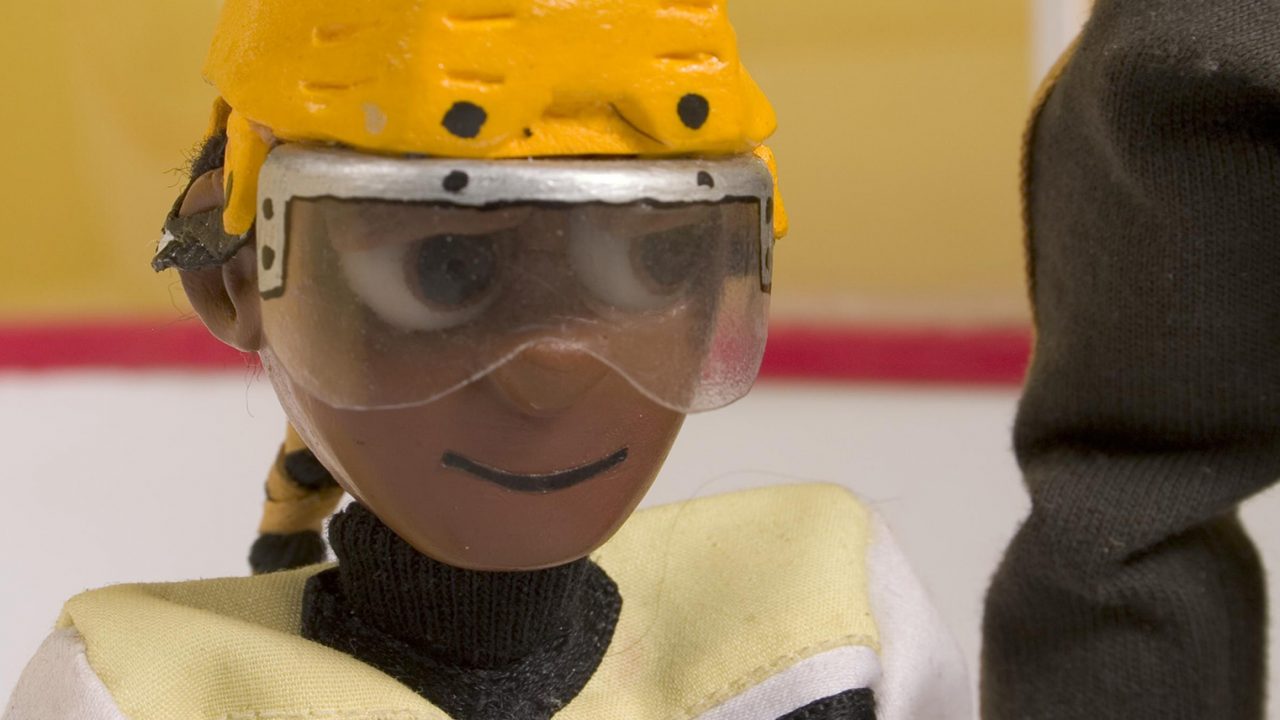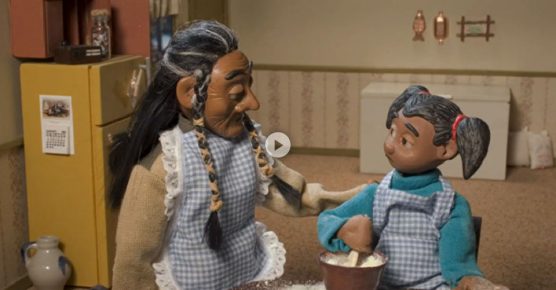
Mini-Lesson for Wapos Bay: There’s No “I” in Hockey
Mini-Lesson for Wapos Bay: There’s No “I” in Hockey
Mini-Lesson for Wapos Bay: There’s No “I” in Hockey
School Subjects:
- Healthy Relationships
- Safety/Fair Play/Leadership
- Personal Health
- Indigenous Language and Worldview
Recommended Ages: 5-8
Wapos Bay: There’s No ‘I’ in Hockey, Dennis Jackson, provided by the National Film Board of Canada
Overarching Question: Can the concept of good sportsmanship be applied to aspects of everyday life as a means of encouraging a positive mindset and the ability to persevere?
Educational Synopsis: Have you ever made choices that strained a relationship? Have you ever wanted to give up on yourself, even when others were counting on you? The activities in this lesson explore what it takes to keep a positive mindset, and how to be a valuable member of a group in order to persevere through life’s challenges.
Activity 1: Teamwork – Hockey Stick Collage
Clip #1a (34s)

Whole class, small group, pairs or independent.
Step 1: If working in a large group, draw a circle representing a hockey puck at the centre of a large piece of paper. If students are working independently, have them draw their own circle on a blank sheet of paper. Write the word “teamwork” in the centre of the circle/hockey puck.
Step 2: Pre-draw and copy simple hockey stick templates, draw hockey sticks or have students draw simple hockey sticks and place them randomly around the puck. Make sure there is enough space inside the shaft of the stick for students to write words or sentences.
Step 3: Brainstorm words or sentences that describe and encourage teamwork, collaboration and group work. Write the words or phrases on the shaft of the hockey stick. Tape or glue the phrases that are written on students’ hockey sticks onto the large group paper. Students may have to cut out all the hockey sticks that they’ve created and then stick them to the group paper. If working independently, students can draw all the hockey sticks and words and phrases onto their paper.
Summary
Teamwork extends beyond sports. Being a part of a team can include cooperating and collaborating within a classroom, group, family or community. A strong team will value the strengths of each individual while learning from each of its members. Another important lesson in this film has to do with valuing the opposing team members’ strengths regardless of gender or other differences.
Within many Indigenous circles, the use of phrases such as “we are all related” and “all my relations,” or “wakotawin” in Cree, is common. Although we are all our own individual beings, we are all interconnected. Seeking, valuing and maintaining positive relationships can help nurture wellbeing.
Activity 2: T-Chart – “Self-Talk”
Clip #2 (1min 32s)
Whole class, small group, pairs or independent.
Step 1: Create a T-Chart using chart paper, a smartboard, or a board if working in larger groups. If students are working independently, each student creates or is provided a T-Chart.
Label each side with either of the following:
“Poor sport” vs. “Good sport”
“Sore loser” vs. “Good sport”
“Negative self-talk” vs. “Positive self-talk”
“Bad thoughts” vs. “Good thoughts”
Step 2: As a group or independently, brainstorm negative words or phrases that someone might say to themselves after losing a game. Ask students to imagine they are being a “poor sport” or being very hard on themselves. Students can also include phrases that someone who’s being negative or a bad sport might say to the other team.
Make a list of the words or phrases and place them under the “negative” side of the T-Chart.
Step 3: What are some positive words or phrases of encouragement that someone might say to themselves or others after losing a game? What are some positive words of encouragement that those who watched a game might say?
Make a list of the positive words or phrases and place them under the “positive” side of the T-Chart.
Differentiation: The teacher may want to prepare a list of positive and negative words or phrases in text boxes. They can print the 10–20 examples and students can cut, glue and sort them into negative and positive categories within the T-Chart.
Step 4: Have students practise saying positive phrases aloud. Positive self-talk and affirmations could be extended and practised as a daily class routine.
Summary
In this episode of Wapos Bay, there are many instances in which some of the characters could have dwelled within a negative mindset. Having a negative mindset fuelled by negative self-talk and behaviour can discourage people from being their best selves. When we practise, model and encourage positive self-talk, we are contributing to our own and others’ best selves. Situations may not always go as planned, but maintaining a positive mindset can help one move forward in a good way as they grow.
Activity 3: Reflect and Share
Step 1: Using Google Search images, type in the words “never give up in Cree.” Project the search results explaining the concept of “ahkamêyimok” to the class.
Step 2: Students independently reflect on when they might tell themselves or someone else to persevere, keep going, keep trying or never give up. The situation could relate to hockey or any other context. The reflection can be written down.
Step 3: Students can share their reflections aloud as a class.
Summary
In this episode of Wapos Bay, several words are spoken in the language of Cree, including the words kohkom (grandmother) and moshum (grandfather), which were most prevalent. Indigenous language is rich and beautiful and needs to persevere. Culture and language are connected. Indigenous language revitalization is critical. Ahkamêyimok is a plains Cree word that can be translated into English as the character trait of “perseverance,” or as “keeping on going,” “never giving up,” or “don’t give up.” Ahkamêyimok can be applied to everyday life, as well as to larger life accomplishments.
Take Action
Create a school poster campaign using the concepts of “Ahkamêyimok” and “Never Give Up” as the source of inspiration. Place the posters around the class or school. Take it farther and post the inspirational posters on a school social media page.
Extension: Download a free Cree app or Indigenous Language app for a language in your area. If you are not sure which nations traditionally reside close to or within your current area, do some research. Once you find the nation and language family that is nearest to you, search for a free language app associated with that Indigenous Language.
Use the app to practise a word a day, a week, or a month. Find out if there are Indigenous place names within your province or territory. What are their English translations? The character trait of “perseverance” was featured in the lesson. What other character traits are there, and can you begin to research how these words translate into Cree or a local Indigenous Language?
Pour lire cet article en français, cliquez ici.
Crystal is a Cree/Dene Métis mother, Educator, Indigenous Education Consultant, and artist who is dedicated to supporting the Calls to Action. She has a background in New Media studies at the Vancouver Film School, a Bachelor of Education, a fine arts degree and a master’s degree in Educational Technology, as well as an Indigenous Creative Writing and Visual Arts diploma from the En’okin Center. She also has extensive experience teaching in First Nations communities, and experience in resource development, research and the facilitation of Indigenous Education for teachers across the province of Alberta, as well as in teaching educational technology to pre-service teachers.
Discover more Mini-Lessons | Watch educational films on NFB Education | Watch educational playlists on NFB Education | Follow NFB Education on Facebook | Follow NFB Education on Pinterest | Subscribe to the NFB Education Newsletter



